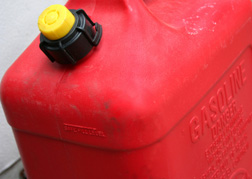 Vents had a tendency to allow for unanticipated spillage as well. Thus, many states have required portable gasoline can manufacturers to design spill-proof containers. In other words, containers without the capacity to vent vapor buildup.
Vents had a tendency to allow for unanticipated spillage as well. Thus, many states have required portable gasoline can manufacturers to design spill-proof containers. In other words, containers without the capacity to vent vapor buildup.This fact struck a California blogger last year the hard way, when she used a portable gasoline can to fill a portable generator. Not realizing that pressure had built up in the non-spillable container, she engaged the button, which would release the fuel, only to find that her act served to release trapped pressure all at once, rather than gradually. The sudden venting of gasoline vapors also brought with it liquid gasoline, which saturated the user's clothes and hair. Gasoline spritzed into her eyes as well.
The generator she was intending to fill was switched off, but had been running and was hot. Luckily, there was no spark…
Her home state of California had passed strict laws governing the gas can industry.
Then there is the issue of the flame arrester—a small, wire mesh device at the base of the nozzle that allows the unimpeded flow of liquid, but can prevent the escape of vapors that can ignite in the presence of a spark.
READ MORE PERSONAL INJURY LEGAL NEWS
The four were rushed to the hospital with critical injuries.
It is not known if the gas can used during the incident was equipped with a flame arrester. Vapors escaping from an opened gas can—especially a can with the contents under pressure—can ignite when in the presence of an open flame or anything capable of generating a spark. The flame arrester can help prevent such an event from occurring, by harnessing flammable vapors inside the can.
It has been reported that most consumer-grade gas cans are manufactured without a flame arrester. Combined with the new-generation, non-spillable containers that no longer have the venting capabilities of older cans, the level of risk to the consumer increases in kind.

READER COMMENTS
Joelr
on
Nayr
on